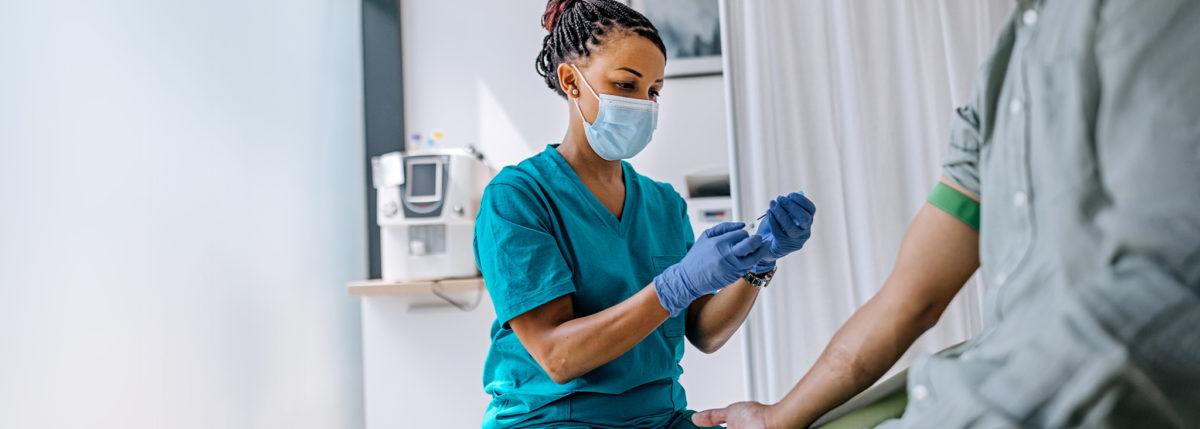A1c Test Results Are More Likely To Be Inaccurate for People Of Color–Here’s Why That Matters
A1c testing is a regular part of living with any type of diabetes. What you might not know is that the most common form of the test is less accurate in people who inherit less common forms of hemoglobin. And–unsurprisingly—this hasn’t been factored into today’s A1c guidelines.
Your A1c is the go-to test used to get an idea of what your average blood sugar level has been during the previous two to three months. Measured as a percentage, a higher A1c indicates that the protein hemoglobin—found in red blood cells—has more sugar stuck to it. In other words, the higher your blood sugar levels are, the more sugar sticks to your red blood cells, thus the higher your A1c result will be.
A1c is commonly used to monitor the success of a diabetes management plan. Higher A1c levels can help your healthcare team determine if you need adjustments in your medications or support with lifestyle changes.
Even though A1c testing is widely used in diabetes care, it’s a long-term snapshot and only one indicator of a person’s blood sugar management. Many people still rely on checking their blood sugar throughout the day to manage their diabetes and some doctors use other tests or metrics to track a person’s diabetes health.
Thanks to advancements in continuous glucose monitoring technology, “time in range” has become a far more effective method of assessing a person’s blood sugar management. But A1c testing is still the primary assessment tool in healthcare.
The American Diabetes Association uses the following guidelines. You can also translate any A1c result into an average blood sugar level using this handy calculator.
| 4.6 – 6.0 | Normal (does not have diabetes) |
| 5.7 – 6.4 | Pre-diabetes (warning that someone may develop type 2) |
| 6.7+ | Diabetes (someone diagnosed with diabetes) |
| <7.0 | Target range for adults diagnosed with diabetes |
| <7.5 | Target range for children and adolescents diagnosed with diabetes |
How did we get here?
Since the 1980s, A1c guidelines have been used to measure and track average blood sugar levels as well as a way to gauge the risk of developing diabetes or its complications.
However, the field of medical research has a troubling history of failing to draw diverse patient pools for research trials, though this is improving, it was no less the case 40 years ago.
As a result, A1c guidelines were created based on data that disproportionately studied white people.
More recent studies of A1c levels showed that there’s diversity among racial and ethnic groups in the U.S. Data shows A1c trends slightly higher in Blacks, Hispanics, American Indians and Asian Americans than in white Americans. This begs the question of whether other factors contribute to A1c variability beyond average blood glucose. As a result, we must question how many people have had their A1c readings misinterpreted based on data and guidelines that didn’t account for their genetic makeup.
It should also be noted that other variables can lead to inaccuracies in anyone’s A1c result. These variables include pregnancy, recently donating blood and recently receiving a blood transfusion.
We know a person’s A1c is, in part, determined by genetics. Data on twins underscore this. Genetics can predispose you to diabetes, however, most people who are at risk, don’t develop diabetes.
The role of hemoglobin variants & genetics
We inherit the type of hemoglobin in our blood from our parents. The most common form is hemoglobin A, though lots of variants exist and some variants can affect A1c test results.
These variants are most common in people with African, South and Southeast Asian and Mediterranean ancestry.
While having a hemoglobin variant does not affect your risk for diabetes, it can affect your A1c. This means that if you have certain hemoglobin variants, this particular test won’t be a good indicator of your diabetes management. Your doctor may then think your blood sugar is higher or lower than it actually is.
If this is the case, you aren’t getting a good snapshot of your long-term blood sugar levels, which can have real consequences for a person’s confidence in their ability to manage their condition, their interactions with healthcare providers and their overall wellbeing.
If this is you, ask your doctor about alternative methods to testing that will more accurately capture your blood glucose levels to inform your diabetes management plan.
Some available alternatives include:
- A1c tests that aren’t affected by hemoglobin variants
- Self-monitoring blood sugar levels multiple times a day, if you aren’t already doing this
- Tests like random or fasting plasma glucose tests
- Fructosamine test shows average glucose levels over about three weeks
Systematic obstacles to comprehensive care
A gold-standard test that isn’t accurate for all patients isn’t just an inconvenience.
Aside from misrepresenting real blood sugar levels in some individuals, there are other consequences for failing to capture the effectiveness of a diabetes management plan.
The consequences of inaccurate testing go beyond their medical care. Life insurance providers may assess how well a chronic condition is managed, which means an inaccurately high A1c level could lead to higher insurance premiums for a person with diabetes.
This is just one example highlighting the need for more diversity in clinical trials to ensure data is accurate and relevant to the population it’s intended to benefit and that this variability is reflected in standards of care.
Even if this oversight is unintentional, its systematic and its impact is unevenly felt across populations in the United States.
Unfortunately, this lack of representation in clinical trials is also reflected in the efficacy of testing, treatment guidelines and standards of care.
What’s it going to take to change that?
Clinical trials are a key part of the process of bringing new drugs, products and treatments to the public. And participating in clinical trials may offer some benefit in the way of early access to a drug or treatment.
But clinical trials lack diverse participant pools. Racial and ethnic minorities have long been underrepresented in clinical trials and survey data shows a person’s income appears to be highly correlated to a person’s likelihood to participate.
Research trials can put high demands on their participants, including in-person doctor’s appointments that are sometimes frequent and may last several hours. Participants may be expected to keep a diary or health log.
There are myriad consequences here, too. The opportunity to potentially access a needed and effective treatment is limited to people whose providers are aware of the ongoing research, and usually, are located in proximity to an area with a research community.
Some potential barriers include:
- The study location has to be as accessible via public transportation if you do not have access to a car
- Participation may require substantial time commitments
- This implies you are physically well enough to travel and participate, have a reliable form of transportation, have a work schedule or workplace policy that accommodates these appointments and have support at home, possibly including childcare
On top of that, few people outside of the healthcare field know how to access a clinical trial that is relevant to them or is up to date on the latest research–commonly, health care providers are the ones referring their patients.
There are also consequences for the quality of research. Patient pools which don’t represent the national population can mean a mismatch in documented drug dosage effects and outcomes based on the research and efficacy in the general population.
In 2020, among 53 drugs newly approved by the U.S. Food and Drug Administration (FDA), white participants made up 75 percent of the clinical trial group. Black and Hispanic participants were enrolled at far lower rates.
Like many other fields, healthcare providers also hold their own inherent biases that can affect how they refer patients to studies. Bias in research data has clear consequences and a focus on better recruiting for clinical trials will make enrollment and participation more accessible.
The field of medicine has a long way to go to represent the population it serves and tailor knowledge and care to the unique needs of any patient.





